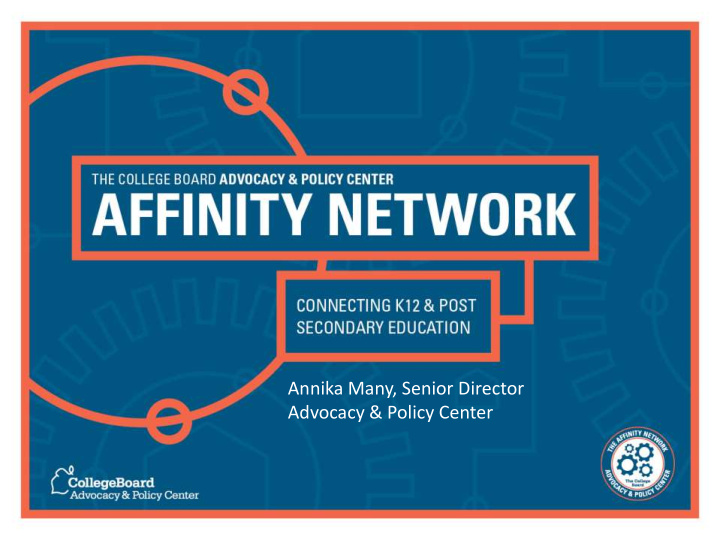



Annika Many, Senior Director Advocacy & Policy Center
PURPOSE • Build and strengthen connections between K – 12 and postsecondary education systems to facilitate successful transition from high school to college. • Provide a service to membership • Serve as an incubator for ideas and solutions for the Advocacy & Policy Center, CB membership, and the education field. • Establish an ongoing process to encourage creative problem solving and strengthen the link between policy and practice, and between education sectors. 2
WHAT WILL THE NETWORK DO? ONE ISSUE; ONE COHORT; ONE YEAR • The Affinity Network will tackle a We select educators and/or administrators across sectors who new critical issue each year that are invested in the issue, with requires linkages between K-12 and expertise and/or knowledge to postsecondary systems; that aligns work together to arrive at to the concerns and needs of workable solutions. College Board membership; and • Participants will meet face-to-face draws on the experience and in and small group sessions; and expertise of the College Board. will communicate via the online community. • Each cohort will work intently for 9-12 months; after which we will identify a new issue and new Network participants. 3
BENEFITS 1. Hands-on technical assistance The Affinity Network 2. Access to the latest policy provides expertise, curates developments, data. and customizes content, and 3. Outside experts and issue-area translates research for leadership. Network participates to 4. Content advisory committee enable them to make 5. Facilitated conversations to encourage problem solving. informed decisions and 6. Moderated online community. generate inspired ideas and 7. Peer-to-peer relationships. solutions 8. No cost to participating institutions; stipends. 4
SUPPORT AND EXPERTISE 1. Researchers and advocacy experts The Center has built a from the College Board cadre of education policy 2. Policy specialists from HCM and advocacy experts to Strategists support the Affinity 3. Facilitators Network 4. Consultants with issue knowledge and experience 5. Expertise in online community building from Collaborative Communication and College Board 5
Online Community 6
Selection Criteria Adoption of Common Core Adoption of Common Core Representation of PARCC and SBAC states Representation of PARCC and SBAC states Representation from variety of College Board regions Representation from variety of College Board regions Representation of both RTTT and non-RTTT winners Representation of both RTTT and non-RTTT winners Urban, Suburban, Rural Mix Urban, Suburban, Rural Mix State and university leadership State and university leadership 7
TEAM MAKEUP TOTAL PARTICIPANTS PER STATE: 33 MAX PARTICIPANTS PER INSTITUTION: 11 STATE 4 YR 2 YR K 12 INSTITUTION INSTITUTION INSTITUTION Head Lead (1) Head Lead (1) Head Lead (1) ELA MATH ELA MATH ELA MATH REPRESENTATIVE REPRESENTATIVE REPRESENTATIVE REPRESENTATIVE REPRESENTATIVE REPRESENTATIVE LEAD (1) LEAD (1) LEAD (1) LEAD (1) LEAD (1) LEAD (1) ELA MATH ELA MATH ELA MATH TEAM TEAM TEAM TEAM TEAM TEAM (up to 4) (up to 4) (up to 4) (up to 4) (up to 4) (up to 4) 8
Key Questions for the 1 st Cohort This year, the Network will seek to answer two key questions: 1. How could the Common Core State Standards result in changes/shifts in the alignment of high school exit expectations with postsecondary entrance expectations? And what supports (legislative, institutional, research, resources, conversations, etc.) need to be in place to successfully accomplish this alignment? 2. How could the Common Core State Standards impact the design of remedial education courses on college campuses ?
Participating States and Institutions 100+ people; 20 institutions; 6 states Georgia Indiana Maryland • University of Georgia • Purdue University North Central • University of Maryland College Park • Georgia Perimeter College • Ivy Tech Community College • Prince George’s Community College Northwest • Gwinnett Public Schools • Prince George’s County Public School • Westville Schools Nevada Oklahoma Washington • University of Nevada, Reno • University of Central Oklahoma • Eastern Washington University • Clark County School District • Oklahoma City Community College • Washington State University – Spokane • Oklahoma City Public Schools • Community Colleges of Spokane • Spokane Public Schools
Advisory Committee Advisors Roles & Responsibilities • Michal Kurlaender, Associate Professor, UC Davis • Respond to queries from the Affinity Network School of Education participants on an ongoing basis • Dane Linn, Executive Director, State Strategy and • Review select content pieces for accuracy Outreach, the College Board • Prepare short briefs/summary pieces based on • Bill McCallum, University Distinguished Professor participants interests of Mathematics and Head of the Department of • Contribute pieces for the blog section of our Mathematics, University of Arizona online community • Nancy Shapiro, Associate Vice-Chancellor for Academic Affairs & Special Assistant to Examples of Content Pieces Chancellor, University System of Maryland • Assessment Development: PARCC and SBAC today • Martha Snyder, Senior Associate, HCM Strategists • College-and-Career Ready: What does this mean? • Natasha Vasavada, Executive Director of • Going extinct? Why remedial education still Standards and Curriculum Alignment Services, matters in the advent of CCSS the College Board • • Does it really matter to us? Why higher education Bruce Vandal, Vice President for Development should be a partner in the CCSS effort. and Outreach, Education Commission of the States • MPR Associates 11
Affinity Network Meetings National launch and Final kickoff Online national meeting community convening April 2012 March 2013 In-state Content meetings Advisory
Affinity Network Outcomes Sharing Best Sharing Best Innovative Innovative Case Studies Case Studies Practices Practices approaches approaches New New Monthly reports Monthly reports Final Report Final Report Partnerships Partnerships Learning/ Learning/ Communication Communication Individual Individual sharing across sharing across links across state links across state learning learning Institutions Institutions institutions institutions
Questions?
Recommend
More recommend